Exhibit 99.1
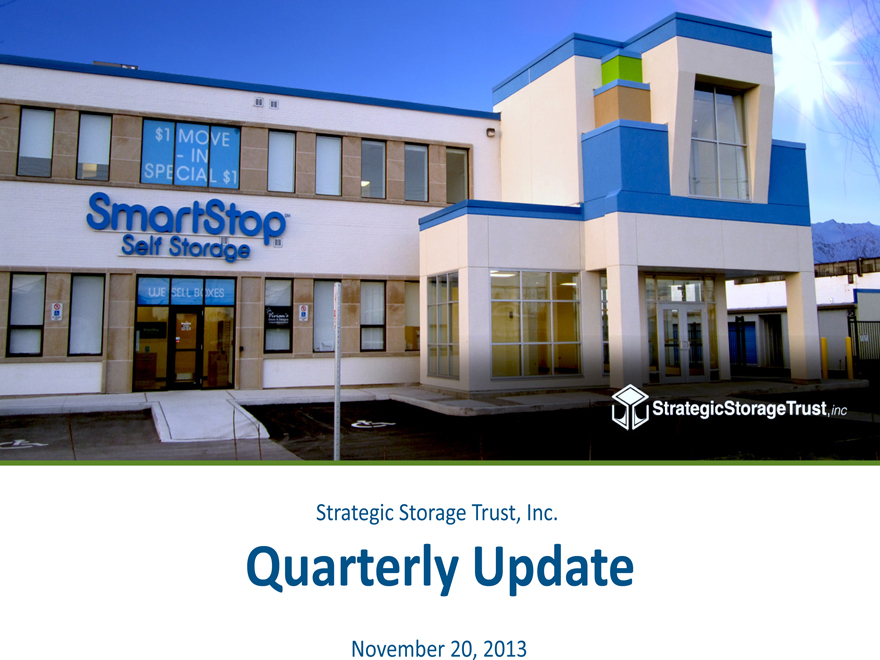
Exhibit 99.1
Strategic Storage Trust, Inc.
Quarterly Update
November 20, 2013
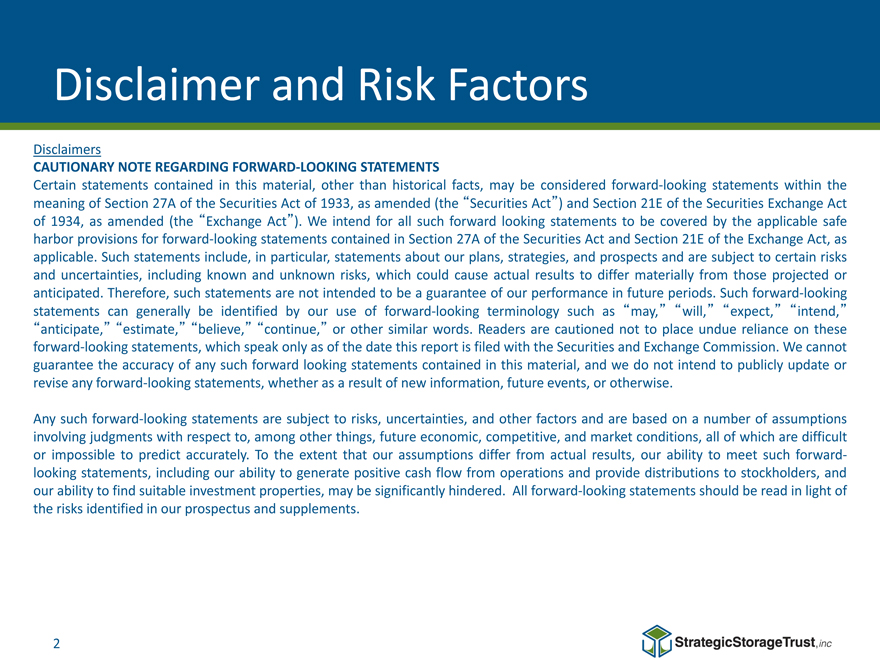
Disclaimer and Risk Factors
Disclaimers
CAUTIONARY NOTE REGARDING FORWARD-LOOKING STATEMENTS
Certain statements contained in this material, other than historical facts, may be considered forward-looking statements within the meaning of Section 27A of the Securities Act of 1933, as amended (the “Securities Act”) and Section 21E of the Securities Exchange Act of 1934, as amended (the “Exchange Act”). We intend for all such forward looking statements to be covered by the applicable safe harbor provisions for forward-looking statements contained in Section 27A of the Securities Act and Section 21E of the Exchange Act, as applicable. Such statements include, in particular, statements about our plans, strategies, and prospects and are subject to certain risks and uncertainties, including known and unknown risks, which could cause actual results to differ materially from those projected or anticipated. Therefore, such statements are not intended to be a guarantee of our performance in future periods. Such forward-looking statements can generally be identified by our use of forward-looking terminology such as “may,”“will,”“expect,”“intend,” “anticipate,”“estimate,”“believe,”“continue,” or other similar words. Readers are cautioned not to place undue reliance on these forward-looking statements, which speak only as of the date this report is filed with the Securities and Exchange Commission. We cannot guarantee the accuracy of any such forward looking statements contained in this material, and we do not intend to publicly update or revise any forward-looking statements, whether as a result of new information, future events, or otherwise.
Any such forward-looking statements are subject to risks, uncertainties, and other factors and are based on a number of assumptions involving judgments with respect to, among other things, future economic, competitive, and market conditions, all of which are difficult or impossible to predict accurately. To the extent that our assumptions differ from actual results, our ability to meet such forward-looking statements, including our ability to generate positive cash flow from operations and provide distributions to stockholders, and our ability to find suitable investment properties, may be significantly hindered. All forward-looking statements should be read in light of the risks identified in our prospectus and supplements.
2
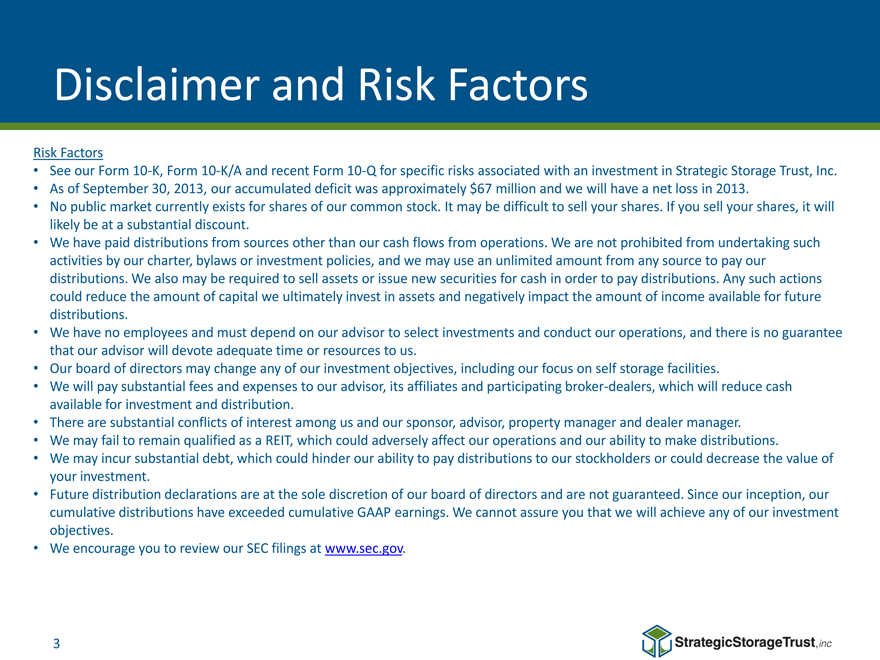
Disclaimer and Risk Factors
Risk Factors
See our Form 10-K, Form 10-K/A and recent Form 10-Q for specific risks associated with an investment in Strategic Storage Trust, Inc.
As of September 30, 2013, our accumulated deficit was approximately $67 million and we will have a net loss in 2013.
No public market currently exists for shares of our common stock. It may be difficult to sell your shares. If you sell your shares, it will likely be at a substantial discount.
We have paid distributions from sources other than our cash flows from operations. We are not prohibited from undertaking such activities by our charter, bylaws or investment policies, and we may use an unlimited amount from any source to pay our distributions. We also may be required to sell assets or issue new securities for cash in order to pay distributions. Any such actions could reduce the amount of capital we ultimately invest in assets and negatively impact the amount of income available for future distributions.
We have no employees and must depend on our advisor to select investments and conduct our operations, and there is no guarantee that our advisor will devote adequate time or resources to us.
Our board of directors may change any of our investment objectives, including our focus on self storage facilities.
We will pay substantial fees and expenses to our advisor, its affiliates and participating broker-dealers, which will reduce cash available for investment and distribution.
There are substantial conflicts of interest among us and our sponsor, advisor, property manager and dealer manager.
We may fail to remain qualified as a REIT, which could adversely affect our operations and our ability to make distributions.
We may incur substantial debt, which could hinder our ability to pay distributions to our stockholders or could decrease the value of your investment.
Future distribution declarations are at the sole discretion of our board of directors and are not guaranteed. Since our inception, our cumulative distributions have exceeded cumulative GAAP earnings. We cannot assure you that we will achieve any of our investment objectives.
We encourage you to review our SEC filings at www.sec.gov.
3
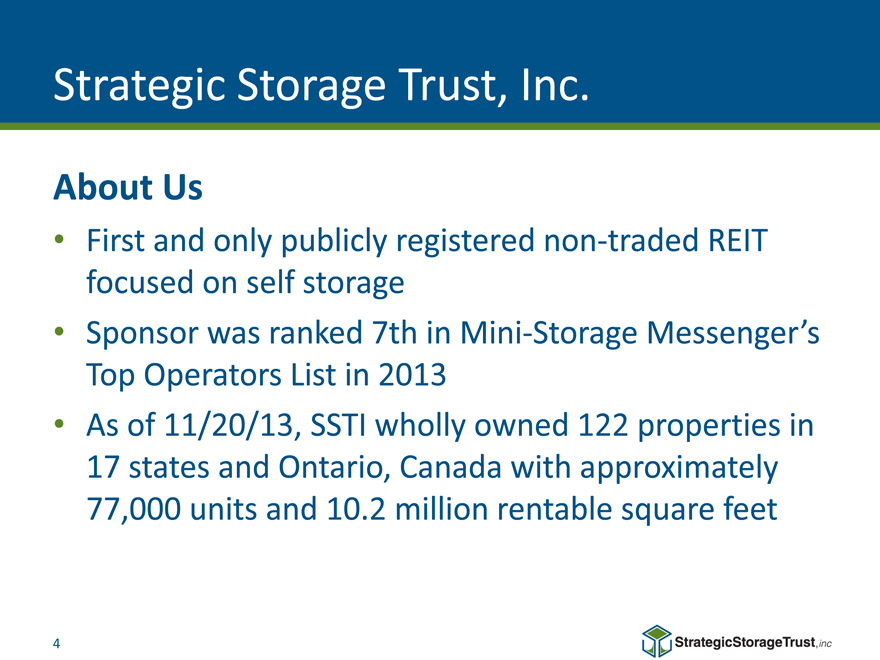
Strategic Storage Trust, Inc.
About Us
First and only publicly registered non-traded REIT focused on self storage
Sponsor was ranked 7th in Mini-Storage Messenger’s Top Operators List in 2013
As of 11/20/13, SSTI wholly owned 122 properties in 17 states and Ontario, Canada with approximately 77,000 units and 10.2 million rentable square feet
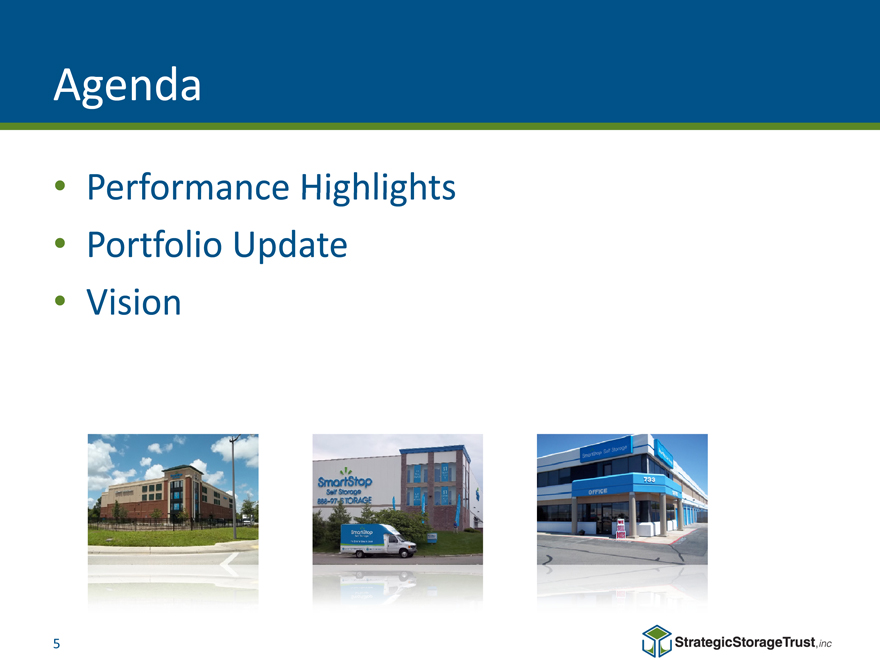
Agenda
Performance Highlights
Portfolio Update
Vision
5
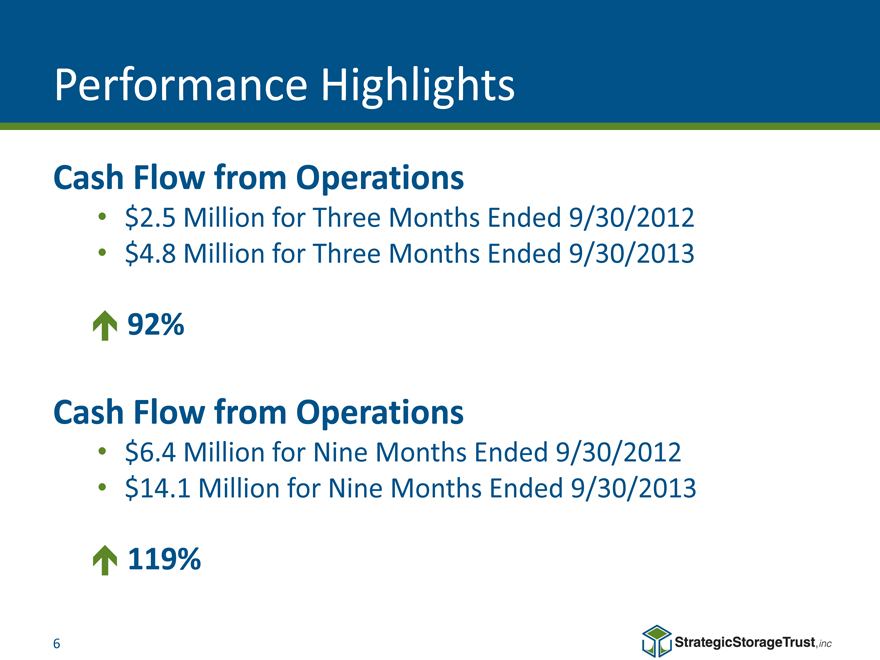
Performance Highlights
Cash Flow from Operations
$2.5 Million for Three Months Ended 9/30/2012
$4.8 Million for Three Months Ended 9/30/2013
92%
Cash Flow from Operations
$6.4 Million for Nine Months Ended 9/30/2012
$14.1 Million for Nine Months Ended 9/30/2013
119%
6
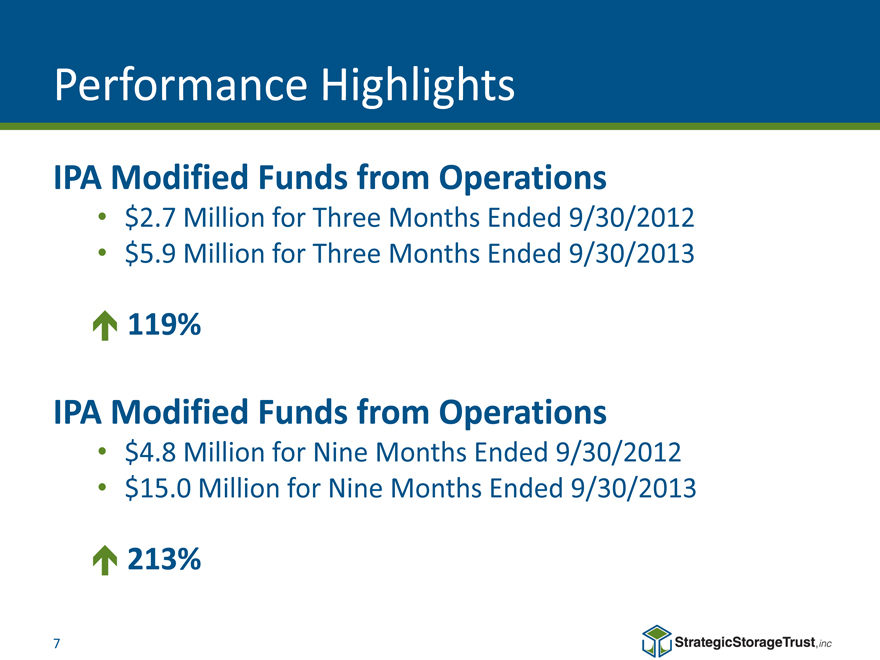
Performance Highlights
IPA Modified Funds from Operations
$2.7 Million for Three Months Ended 9/30/2012
$5.9 Million for Three Months Ended 9/30/2013
119%
IPA Modified Funds from Operations
$4.8 Million for Nine Months Ended 9/30/2012
$15.0 Million for Nine Months Ended 9/30/2013
213%
7
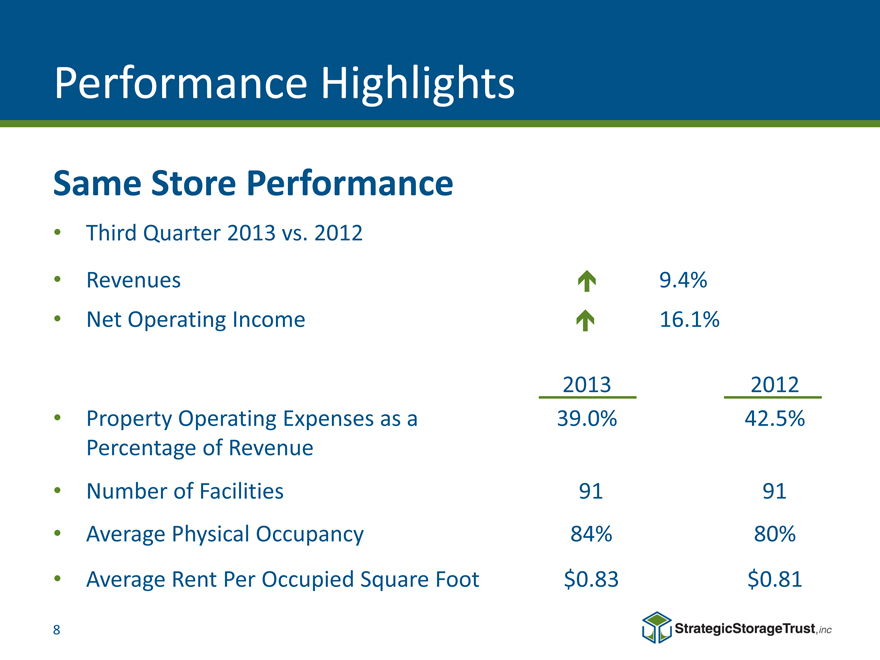
Performance Highlights
Same Store Performance
Third Quarter 2013 vs. 2012
Revenues
Net Operating Income
Property Operating Expenses as a Percentage of Revenue
Number of Facilities
Average Physical Occupancy
Average Rent Per Occupied Square Foot
9.4%
16.1%
2013 2012
39.0% 42.5%
91 91 84% 80%
$0.83 $0.81
8
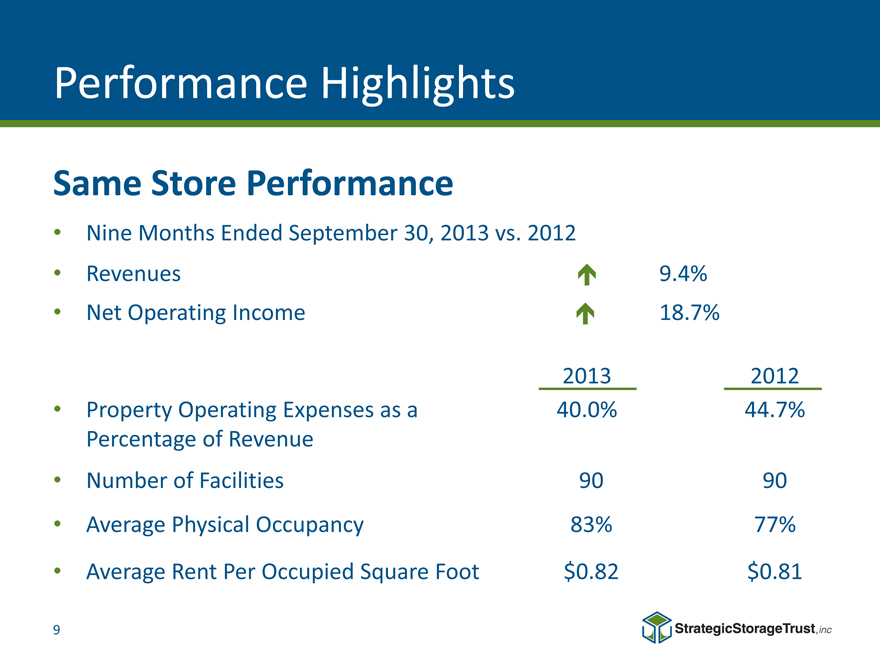
Performance Highlights
Same Store Performance
Nine Months Ended September 30, 2013 vs. 2012
Revenues 9.4%
Net Operating Income 18.7%
2013 2012
Property Operating Expenses as a 40.0% 44.7% Percentage of Revenue
Number of Facilities 90 90
Average Physical Occupancy 83% 77%
Average Rent Per Occupied Square Foot $0.82 $0.81
9
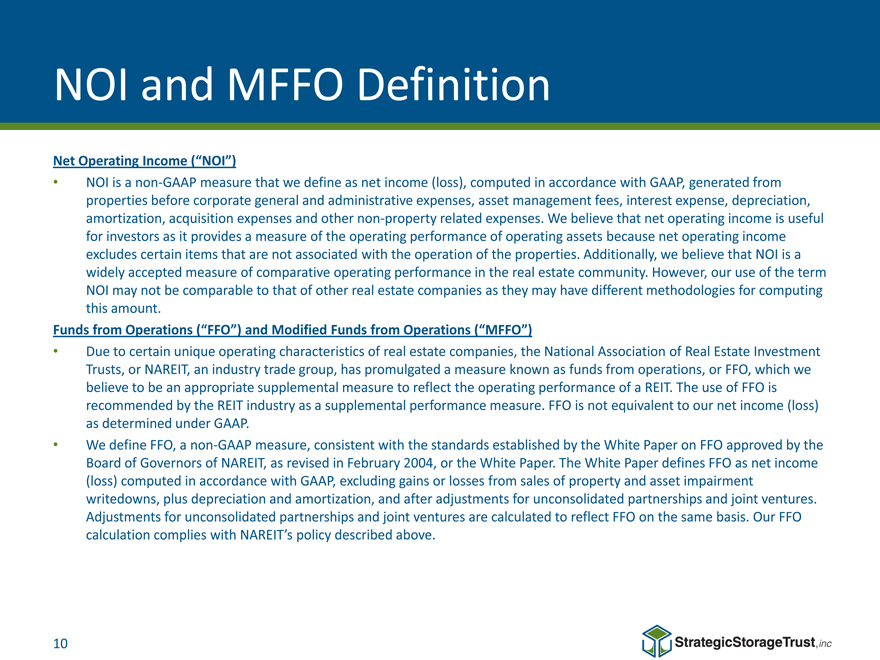
NOI and MFFO Definition
Net Operating Income (“NOI”)
NOI is a non-GAAP measure that we define as net income (loss), computed in accordance with GAAP, generated from properties before corporate general and administrative expenses, asset management fees, interest expense, depreciation, amortization, acquisition expenses and other non-property related expenses. We believe that net operating income is useful for investors as it provides a measure of the operating performance of operating assets because net operating income excludes certain items that are not associated with the operation of the properties. Additionally, we believe that NOI is a widely accepted measure of comparative operating performance in the real estate community. However, our use of the term NOI may not be comparable to that of other real estate companies as they may have different methodologies for computing this amount.
Funds from Operations (“FFO”) and Modified Funds from Operations (“MFFO”)
Due to certain unique operating characteristics of real estate companies, the National Association of Real Estate Investment Trusts, or NAREIT, an industry trade group, has promulgated a measure known as funds from operations, or FFO, which we believe to be an appropriate supplemental measure to reflect the operating performance of a REIT. The use of FFO is recommended by the REIT industry as a supplemental performance measure. FFO is not equivalent to our net income (loss) as determined under GAAP.
We define FFO, a non-GAAP measure, consistent with the standards established by the White Paper on FFO approved by the Board of Governors of NAREIT, as revised in February 2004, or the White Paper. The White Paper defines FFO as net income (loss) computed in accordance with GAAP, excluding gains or losses from sales of property and asset impairment writedowns, plus depreciation and amortization, and after adjustments for unconsolidated partnerships and joint ventures. Adjustments for unconsolidated partnerships and joint ventures are calculated to reflect FFO on the same basis. Our FFO calculation complies with NAREIT’s policy described above.
10

NOI and MFFO Definition - Con’t
The historical accounting convention used for real estate assets requires straight-line depreciation of buildings and improvements, which implies that the value of real estate assets diminishes predictably over time. Diminution in value may occur if such assets are not adequately maintained or repaired and renovated as required by relevant circumstances or other measures necessary to maintain the assets are not undertaken. However, we believe that, since real estate values historically rise and fall with market conditions, including inflation, interest rates, the business cycle, unemployment and consumer spending, presentations of operating results for a REIT using historical accounting for depreciation may be less informative. In addition, in the determination of FFO, we believe it is appropriate to disregard impairment charges, as this is a fair value adjustment that is largely based on market fluctuations and assessments regarding general market conditions which can change over time. An asset will only be evaluated for impairment if certain impairment indications exist and if the carrying value, or book value, exceeds the total estimated undiscounted future cash flows (including net rental revenues, net proceeds on the sale of the property, and any other ancillary cash flows at a property or group level under GAAP) from such asset. Testing for impairment is a continuous process and is analyzed on a quarterly basis. Investors should note, however, that determinations of whether impairment charges have been incurred are based partly on anticipated operating performance, because estimated undiscounted future cash flows from a property, including estimated future net rental revenues, net proceeds on the sale of the property, and certain other ancillary cash flows, are taken into account in determining whether an impairment charge has been incurred. While impairment charges are excluded from the calculation of FFO as described above, investors are cautioned that due to the fact that impairments are based on estimated future undiscounted cash flows and that we intend to have a relatively limited term of our operations; it could be difficult to recover any impairment charges through the eventual sale of the property. To date, we have not recognized any impairments.
Historical accounting for real estate involves the use of GAAP. Any other method of accounting for real estate such as the fair value method cannot be construed to be any more accurate or relevant than the comparable methodologies of real estate valuation found in GAAP. Nevertheless, we believe that the use of FFO, which excludes the impact of real estate related depreciation and amortization and impairments, assists in providing a more complete understanding of our performance to investors and to our management, and when compared year over year, reflects the impact on our operations from trends in occupancy rates, rental rates, operating costs, general and administrative expenses, and interest costs, which may not be immediately apparent from net income (loss).
11
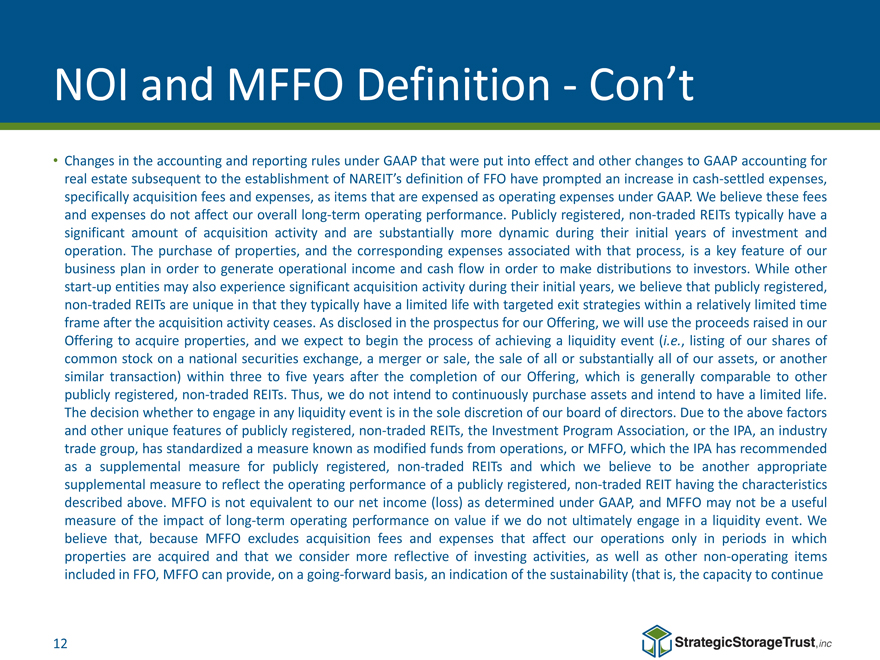
NOI and MFFO Definition - Con’t
Changes in the accounting and reporting rules under GAAP that were put into effect and other changes to GAAP accounting for real estate subsequent to the establishment of NAREIT’s definition of FFO have prompted an increase in cash-settled expenses, specifically acquisition fees and expenses, as items that are expensed as operating expenses under GAAP. We believe these fees and expenses do not affect our overall long-term operating performance. Publicly registered, non-traded REITs typically have a significant amount of acquisition activity and are substantially more dynamic during their initial years of investment and operation. The purchase of properties, and the corresponding expenses associated with that process, is a key feature of our business plan in order to generate operational income and cash flow in order to make distributions to investors. While other start-up entities may also experience significant acquisition activity during their initial years, we believe that publicly registered, non-traded REITs are unique in that they typically have a limited life with targeted exit strategies within a relatively limited time frame after the acquisition activity ceases. As disclosed in the prospectus for our Offering, we will use the proceeds raised in our Offering to acquire properties, and we expect to begin the process of achieving a liquidity event (i.e., listing of our shares of common stock on a national securities exchange, a merger or sale, the sale of all or substantially all of our assets, or another similar transaction) within three to five years after the completion of our Offering, which is generally comparable to other publicly registered, non-traded REITs. Thus, we do not intend to continuously purchase assets and intend to have a limited life. The decision whether to engage in any liquidity event is in the sole discretion of our board of directors. Due to the above factors and other unique features of publicly registered, non-traded REITs, the Investment Program Association, or the IPA, an industry trade group, has standardized a measure known as modified funds from operations, or MFFO, which the IPA has recommended as a supplemental measure for publicly registered, non-traded REITs and which we believe to be another appropriate supplemental measure to reflect the operating performance of a publicly registered, non-traded REIT having the characteristics described above. MFFO is not equivalent to our net income (loss) as determined under GAAP, and MFFO may not be a useful measure of the impact of long-term operating performance on value if we do not ultimately engage in a liquidity event. We believe that, because MFFO excludes acquisition fees and expenses that affect our operations only in periods in which properties are acquired and that we consider more reflective of investing activities, as well as other non-operating items included in FFO, MFFO can provide, on a going-forward basis, an indication of the sustainability (that is, the capacity to continue
12
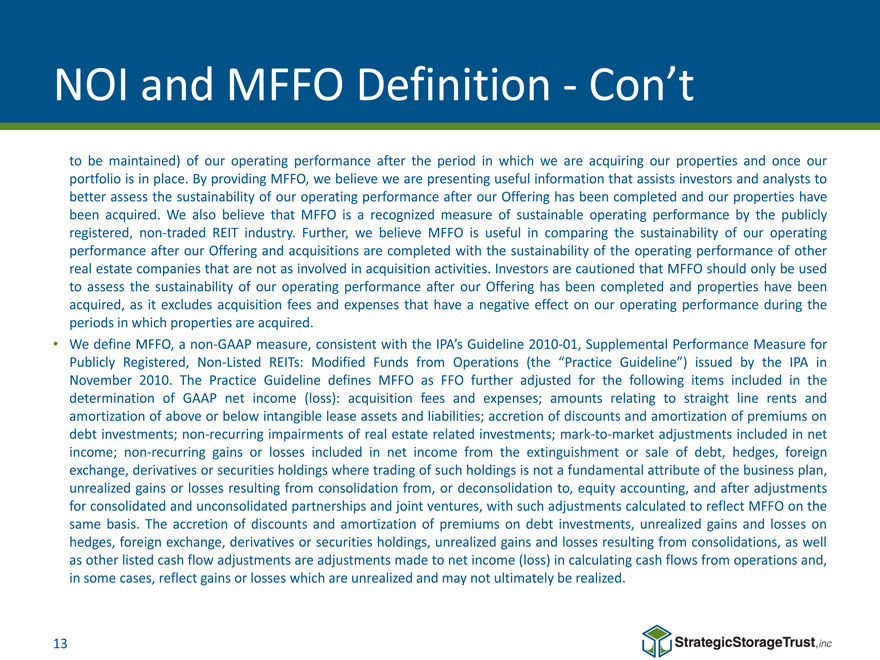
NOI and MFFO Definition - Con’t
to be maintained) of our operating performance after the period in which we are acquiring our properties and once our portfolio is in place. By providing MFFO, we believe we are presenting useful information that assists investors and analysts to better assess the sustainability of our operating performance after our Offering has been completed and our properties have been acquired. We also believe that MFFO is a recognized measure of sustainable operating performance by the publicly registered, non-traded REIT industry. Further, we believe MFFO is useful in comparing the sustainability of our operating performance after our Offering and acquisitions are completed with the sustainability of the operating performance of other real estate companies that are not as involved in acquisition activities. Investors are cautioned that MFFO should only be used to assess the sustainability of our operating performance after our Offering has been completed and properties have been acquired, as it excludes acquisition fees and expenses that have a negative effect on our operating performance during the periods in which properties are acquired.
We define MFFO, a non-GAAP measure, consistent with the IPA’s Guideline 2010-01, Supplemental Performance Measure for Publicly Registered, Non-Listed REITs: Modified Funds from Operations (the “Practice Guideline”) issued by the IPA in November 2010. The Practice Guideline defines MFFO as FFO further adjusted for the following items included in the determination of GAAP net income (loss): acquisition fees and expenses; amounts relating to straight line rents and amortization of above or below intangible lease assets and liabilities; accretion of discounts and amortization of premiums on debt investments; non-recurring impairments of real estate related investments; mark-to-market adjustments included in net income; non-recurring gains or losses included in net income from the extinguishment or sale of debt, hedges, foreign exchange, derivatives or securities holdings where trading of such holdings is not a fundamental attribute of the business plan, unrealized gains or losses resulting from consolidation from, or deconsolidation to, equity accounting, and after adjustments for consolidated and unconsolidated partnerships and joint ventures, with such adjustments calculated to reflect MFFO on the same basis. The accretion of discounts and amortization of premiums on debt investments, unrealized gains and losses on hedges, foreign exchange, derivatives or securities holdings, unrealized gains and losses resulting from consolidations, as well as other listed cash flow adjustments are adjustments made to net income (loss) in calculating cash flows from operations and, in some cases, reflect gains or losses which are unrealized and may not ultimately be realized.
13
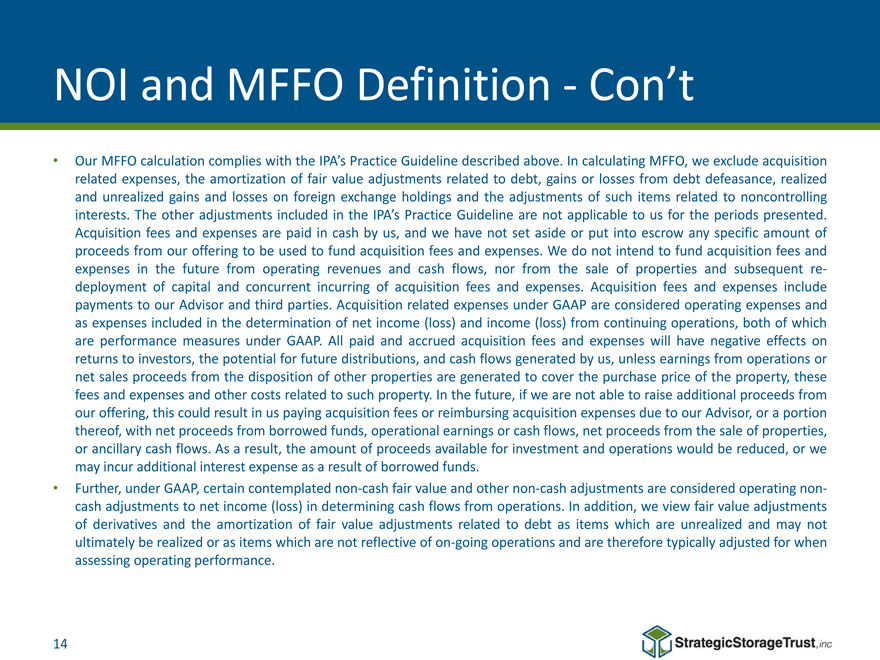
NOI and MFFO Definition - Con’t
Our MFFO calculation complies with the IPA’s Practice Guideline described above. In calculating MFFO, we exclude acquisition related expenses, the amortization of fair value adjustments related to debt, gains or losses from debt defeasance, realized and unrealized gains and losses on foreign exchange holdings and the adjustments of such items related to noncontrolling interests. The other adjustments included in the IPA’s Practice Guideline are not applicable to us for the periods presented. Acquisition fees and expenses are paid in cash by us, and we have not set aside or put into escrow any specific amount of proceeds from our offering to be used to fund acquisition fees and expenses. We do not intend to fund acquisition fees and expenses in the future from operating revenues and cash flows, nor from the sale of properties and subsequent re-deployment of capital and concurrent incurring of acquisition fees and expenses. Acquisition fees and expenses include payments to our Advisor and third parties. Acquisition related expenses under GAAP are considered operating expenses and as expenses included in the determination of net income (loss) and income (loss) from continuing operations, both of which are performance measures under GAAP. All paid and accrued acquisition fees and expenses will have negative effects on returns to investors, the potential for future distributions, and cash flows generated by us, unless earnings from operations or net sales proceeds from the disposition of other properties are generated to cover the purchase price of the property, these fees and expenses and other costs related to such property. In the future,if we are not able to raise additional proceeds from our offering, this could result in us paying acquisition fees or reimbursing acquisition expenses due to our Advisor, or a portion thereof, with net proceeds from borrowed funds, operational earnings or cash flows, net proceeds from the sale of properties, or ancillary cash flows. As a result, the amount of proceeds available for investment and operations would be reduced, or we may incur additional interest expense as a result of borrowed funds.
Further, under GAAP, certain contemplated non-cash fair value and other non-cash adjustments are considered operating non-cash adjustments to net income (loss) in determining cash flows from operations. In addition, we view fair value adjustments of derivatives and the amortization of fair value adjustments related to debt as items which are unrealized and may not ultimately be realized or as items which are not reflective of on-going operations and are therefore typically adjusted for when assessing operating performance.
14
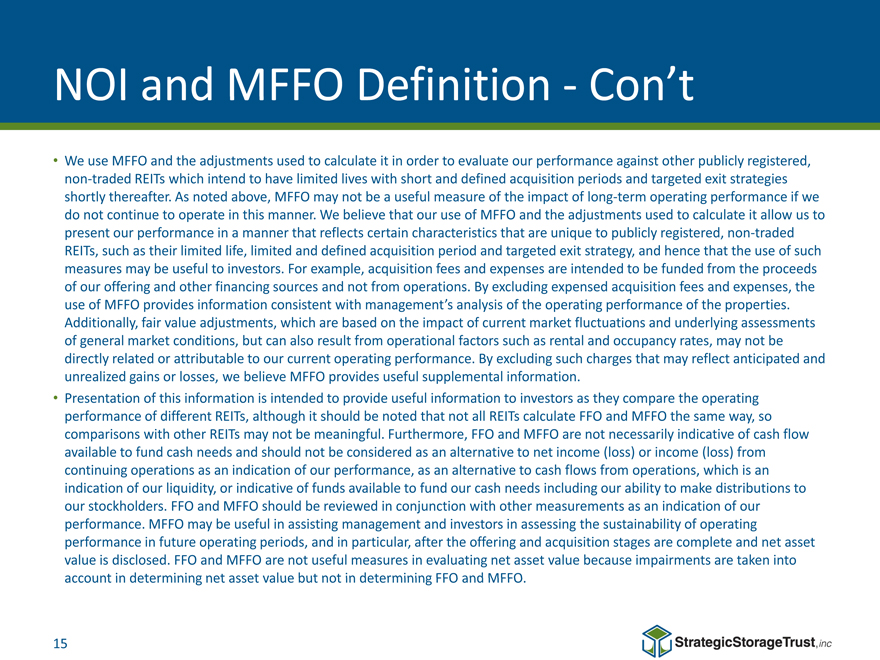
NOI and MFFO Definition - Con’t
We use MFFO and the adjustments used to calculate it in order to evaluate our performance against other publicly registered, non-traded REITs which intend to have limited lives with short and defined acquisition periods and targeted exit strategies shortly thereafter. As noted above, MFFO may not be a useful measure of the impact of long-term operating performance if we do not continue to operate in this manner. We believe that our use of MFFO and the adjustments used to calculate it allow us to present our performance in a manner that reflects certain characteristics that are unique to publicly registered, non-traded REITs, such as their limited life, limited and defined acquisition period and targeted exit strategy, and hence that the use of such measures may be useful to investors. For example, acquisition fees and expenses are intended to be funded from the proceeds of our offering and other financing sources and not from operations. By excluding expensed acquisition fees and expenses, the use of MFFO provides information consistent with management’s analysis of the operating performance of the properties. Additionally, fair value adjustments, which are based on the impact of current market fluctuations and underlying assessments of general market conditions, but can also result from operational factors such as rental and occupancy rates, may not be directly related or attributable to our current operating performance. By excluding such charges that may reflect anticipated and unrealized gains or losses, we believe MFFO provides useful supplemental information.
Presentation of this information is intended to provide useful information to investors as they compare the operating performance of different REITs, although it should be noted that not all REITs calculate FFO and MFFO the same way, so comparisons with other REITs may not be meaningful. Furthermore, FFO and MFFO are not necessarily indicative of cash flow available to fund cash needs and should not be considered as an alternative to net income (loss) or income (loss) from continuing operations as an indication of our performance, as an alternative to cash flows from operations, which is an indication of our liquidity, or indicative of funds available to fund our cash needs including our ability to make distributions to our stockholders. FFO and MFFO should be reviewed in conjunction with other measurements as an indication of our performance. MFFO may be useful in assisting management and investors in assessing the sustainability of operating performance in future operating periods, and in particular, after the offering and acquisition stages are complete and net asset value is disclosed. FFO and MFFO are not useful measures in evaluating net asset value because impairments are taken into account in determining net asset value but not in determining FFO and MFFO.
15
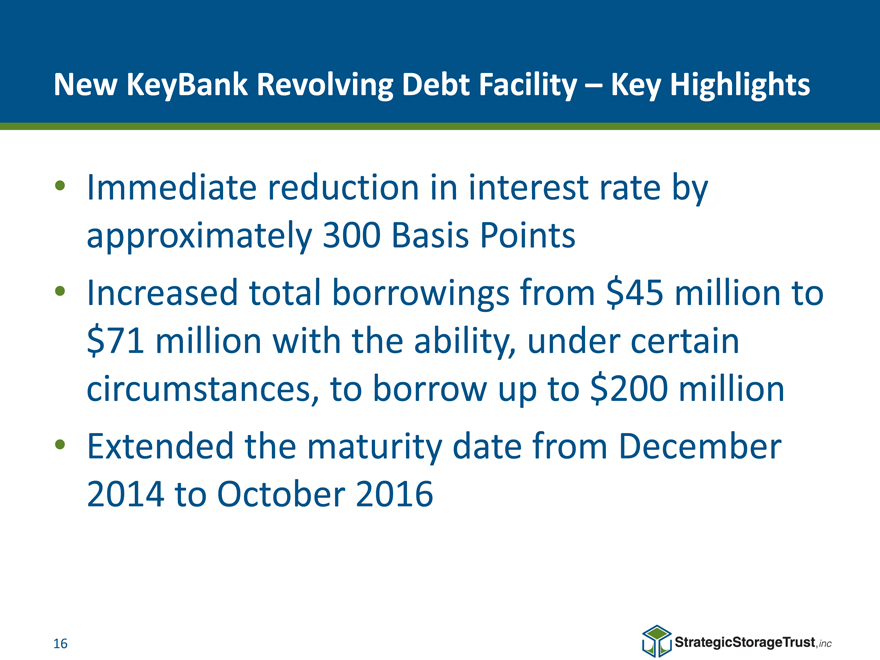
New KeyBank Revolving Debt Facility – Key Highlights
Immediate reduction in interest rate by approximately 300 Basis Points
Increased total borrowings from $45 million to $71 million with the ability, under certain circumstances, to borrow up to $200 million
Extended the maturity date from December 2014 to October 2016
16
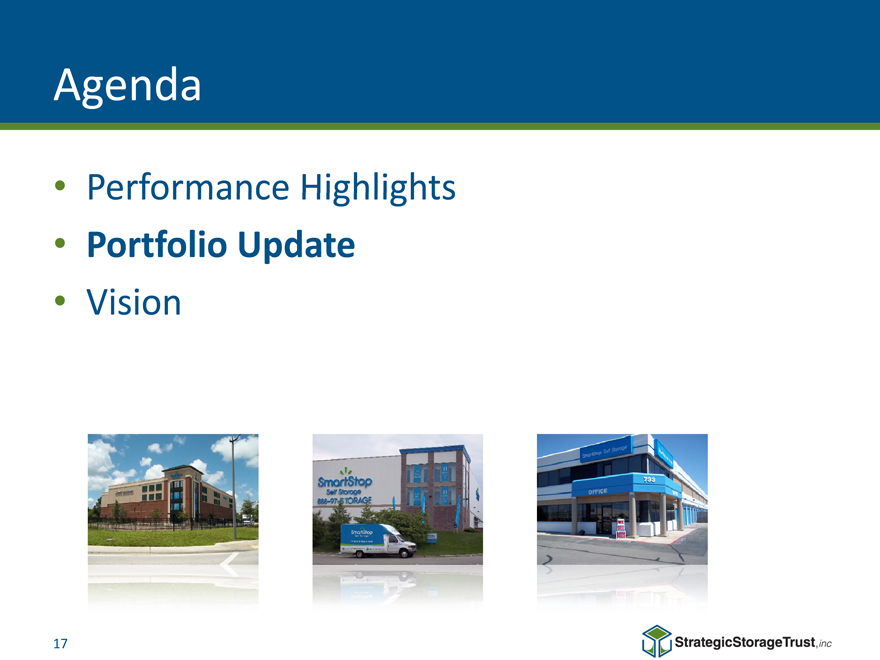
Agenda
Performance Highlights
Portfolio Update
Vision
17
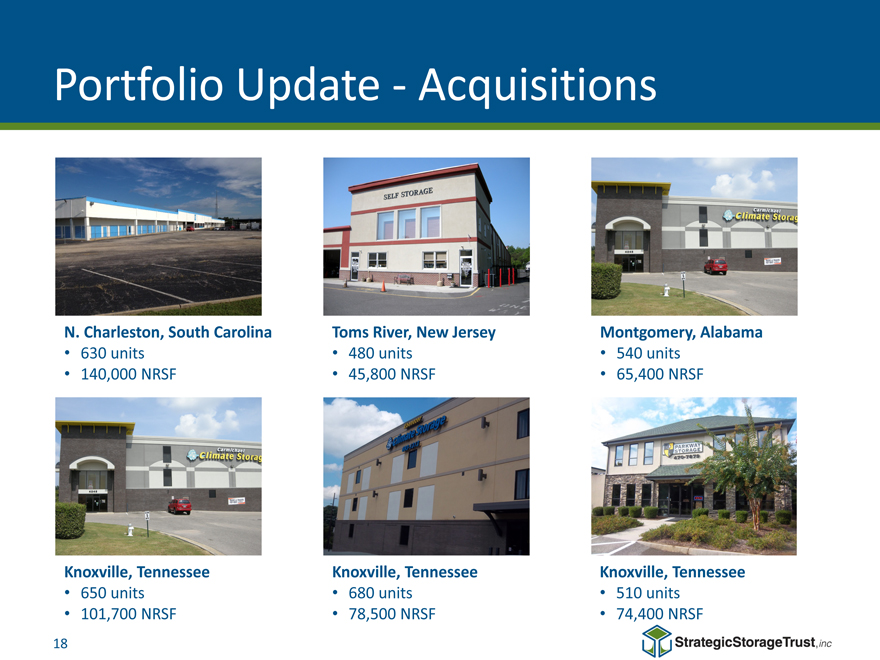
Portfolio Update—Acquisitions
N. Charleston, South Carolina Toms River, New Jersey Montgomery, Alabama
630 units 480 units 540 units
140,000 NRSF 45,800 NRSF 65,400 NRSF
Knoxville, Tennessee Knoxville, Tennessee Knoxville, Tennessee
650 units 680 units 510 units
101,700 NRSF 78,500 NRSF 74,400 NRSF
18
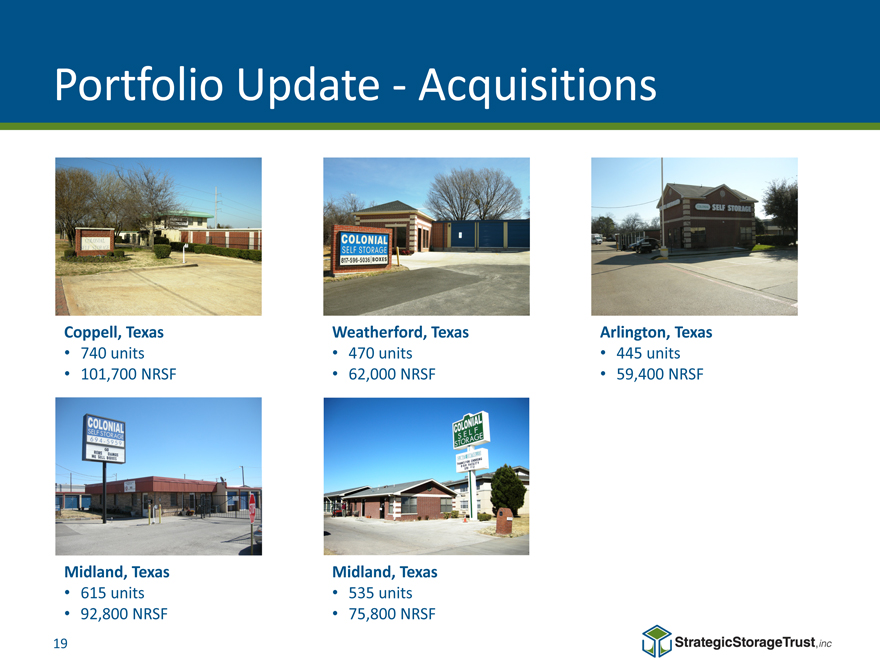
Portfolio Update—Acquisitions
Coppell, Texas
740 units
101,700 NRSF
Weatherford, Texas
470 units
62,000 NRSF
Arlington, Texas
445 units
59,400 NRSF
Midland, Texas
615 units
92,800 NRSF
Midland, Texas
535 units
75,800 NRSF
19
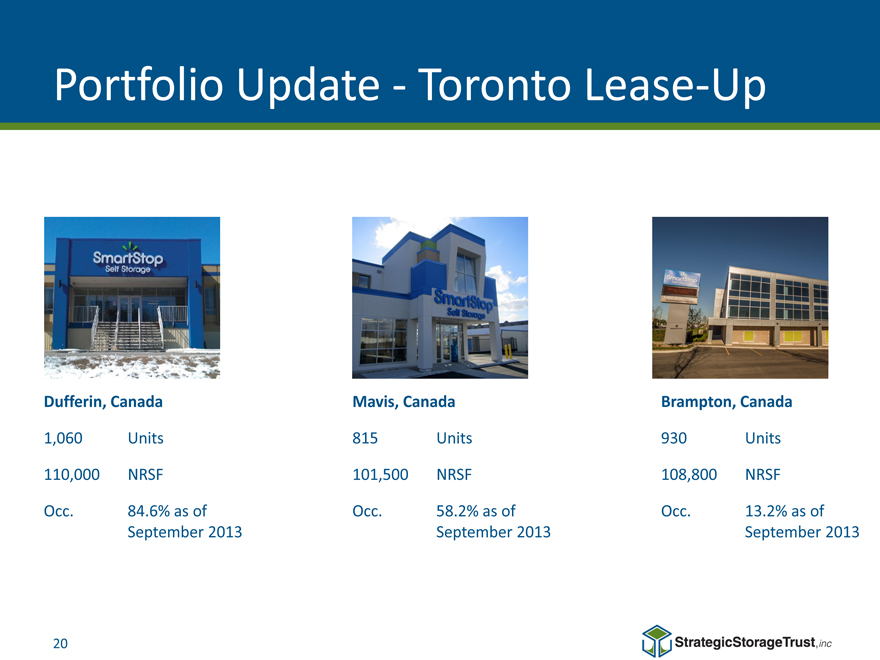
Portfolio Update—Toronto Lease-Up
Dufferin, Canada
1,060 Units
110,000 NRSF
Occ. 84.6% as of September 2013
Mavis, Canada
815 Units
101,500 NRSF
Occ. 58.2% as of September 2013
Brampton, Canada
930 Units
108,800 NRSF
Occ. 13.2% as of September 2013
20
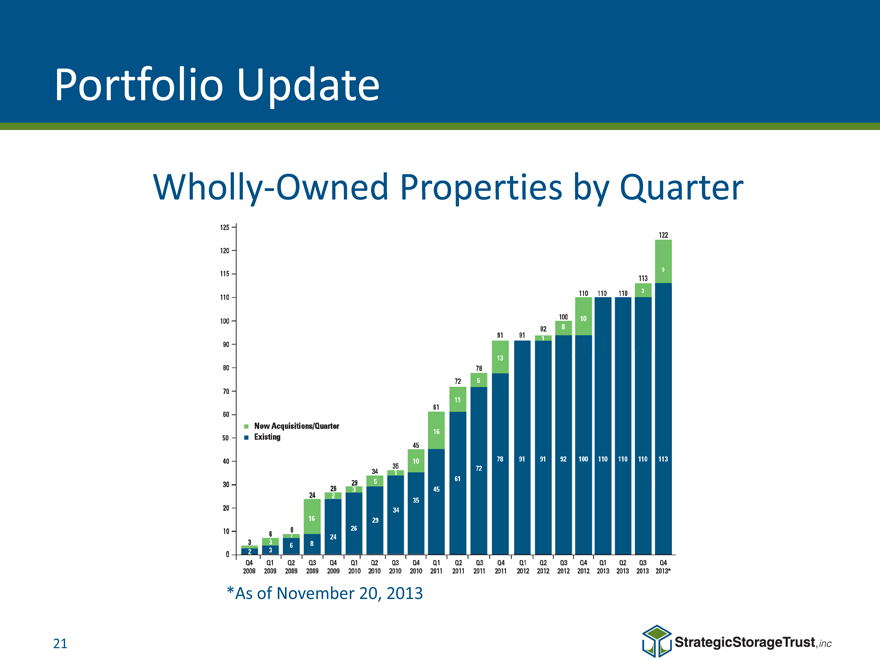
Portfolio Update
Wholly-Owned Properties by Quarter
New acquisitions/Quarter
Existing
0 10 20 30 40 50 60 70 80 90 100 110 115 120 125
Q4 Q1 Q2 Q3 Q4 Q1 Q2 Q3 Q4 Q1 Q2 Q3 Q4 Q1 Q2 Q3 Q4 Q1 Q2 Q3 Q4
2008 2009 2009 2009 2009 2010 2010 2010 2010 2011 2011 2011 2011 2012 2012 2012 2012 2013 2013 2013 2013*
2 3 6 8 24 26 29 34 35 45 61 72 78 91 91 92 100 110 110 110 113
3 6 8 24 26 29 34 35 45 61 72 78 91 91 92 100 110 110 110 113 122
1 3 2 16 2 3 5 1 10 16 11 6 13 1 8 10 3 9
*As of November 20, 2013
21
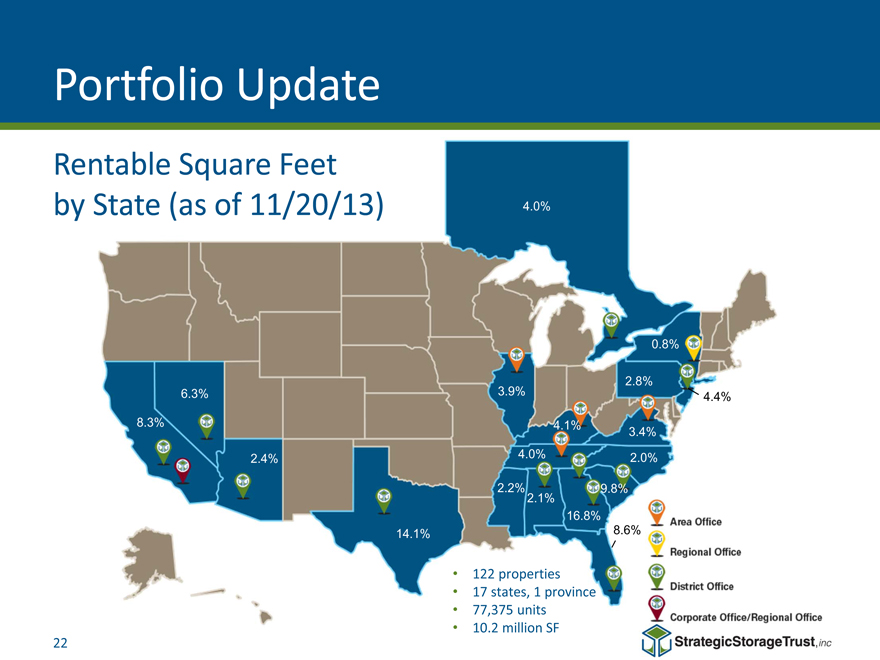
Portfolio Update
Rentable Square Feet by State (as of 11/20/13)
4.0%
2.8%
3.9%
4.1%
3.4%
4.0% 2.
2.2% 9.8%
2.1%
16.8%
14.1% 8.6%
4.4%
122 properties
17 states, 1 province
77,375 units
10.2 million SF
8.3% 6.3% 2.4% 0.8% 2.0%
22
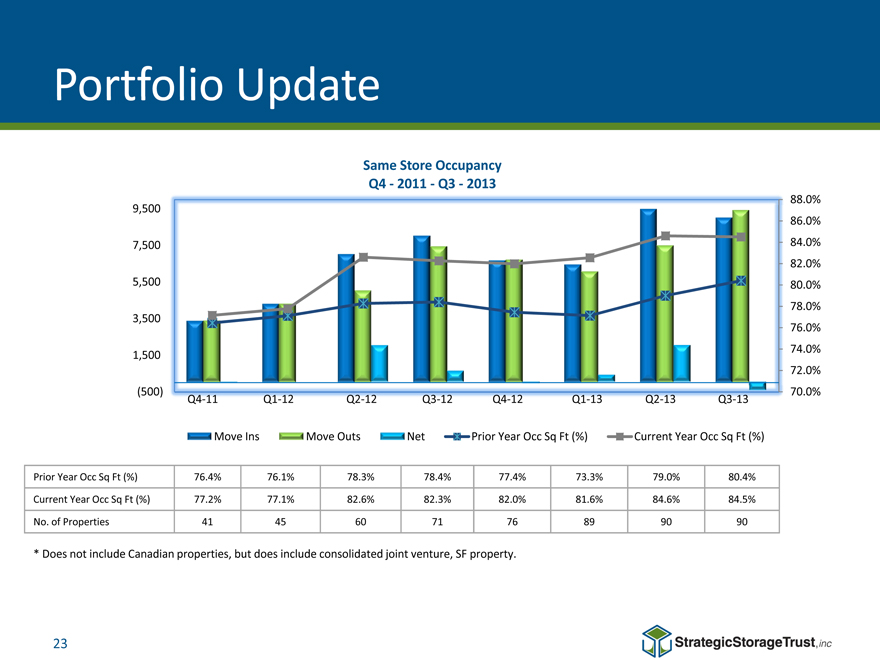
Portfolio Update
Same Store Occupancy Q4—2011—Q3—2013
9,500 7,500 5,500 3,500 1,500 (500)
88.0% 86.0% 84.0% 82.0% 80.0% 78.0% 76.0% 74.0% 72.0% 70.0%
Q4-11 Q1-12 Q2-12 Q3-12 Q4-12 Q1-13 Q2-13 Q3-13
Move Ins Move Outs Net Prior Year Occ Sq Ft (%) Current Year Occ Sq Ft (%)
Prior Year Occ Sq Ft (%) 76.4% 76.1% 78.3% 78.4% 77.4% 73.3% 79.0% 80.4% Current Year Occ Sq Ft (%) 77.2% 77.1% 82.6% 82.3% 82.0% 81.6% 84.6% 84.5% No. of Properties 41 45 60 71 76 89 90 90
* Does not include Canadian properties, but does include consolidated joint venture, SF property.
23
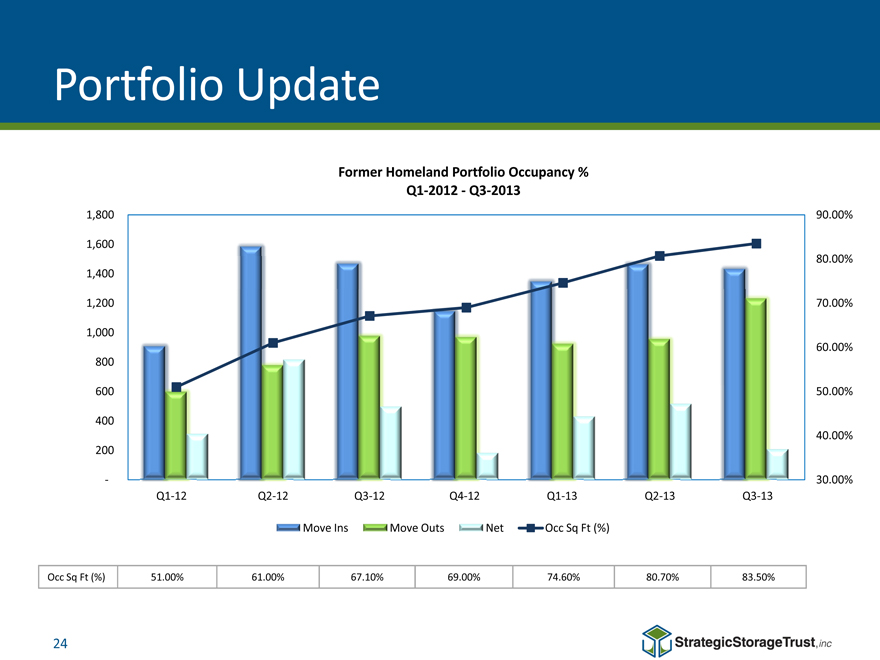
Portfolio Update
Former Homeland Portfolio Occupancy % Q1-2012—Q3-2013
1,800 1,600 1,400 1,200 1,000 800 600 400 200 -
90.00%
80.00%
70.00%
60.00%
50.00%
40.00%
30.00%
Q1-12 Q2-12 Q3-12 Q4-12 Q1-13 Q2-13 Q3-13
Move Ins Move Outs Net Occ Sq Ft (%)
Occ Sq Ft (%) 51.00% 61.00% 67.10% 69.00% 74.60% 80.70% 83.50%
24
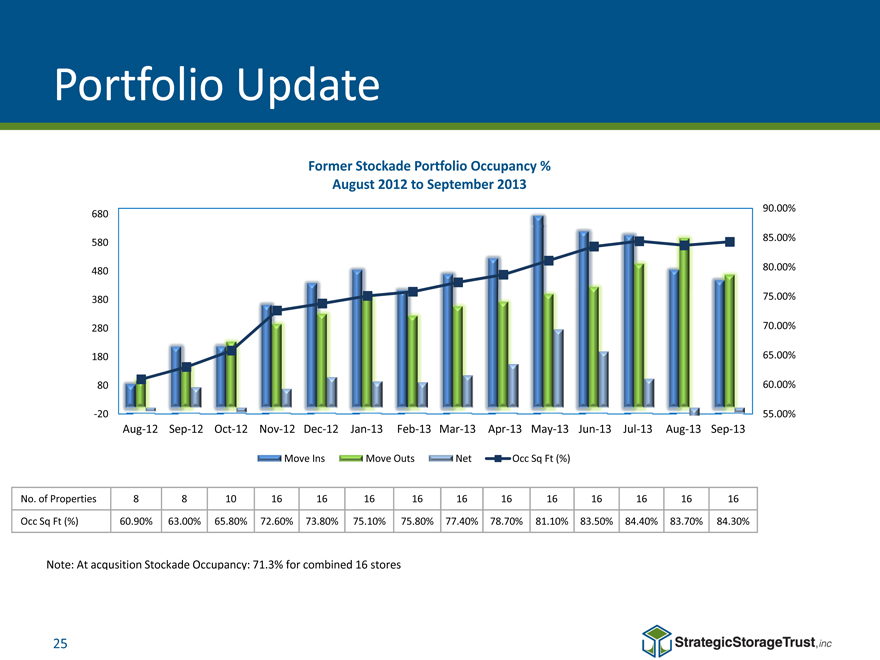
Portfolio Update
Former Stockade Portfolio Occupancy % August 2012 to September 2013
680 580 480 380 280 180 80 -20
90.00%
85.00%
80.00%
75.00%
70.00%
65.00%
60.00%
55.00%
Aug-12 Sep-12 Oct-12 Nov-12 Dec-12 Jan-13 Feb-13 Mar-13 Apr-13 May-13 Jun-13 Jul-13 Aug-13 Sep-13
Move Ins Move Outs Net Occ Sq Ft (%)
No. of Properties 8 8 10 16 16 16 16 16 16 16 16 16 16 16
Occ Sq Ft (%) 60.90% 63.00% 65.80% 72.60% 73.80% 75.10% 75.80% 77.40% 78.70% 81.10% 83.50% 84.40% 83.70% 84.30%
Note: At acqusition Stockade Occupancy: 71.3% for combined 16 stores
25

Portfolio Update
Mavis Rental Income & Occupancy (February 2012—September 2013)
$80,000 $70,000 $60,000 $50,000 $40,000 $30,000 $20,000 $10,000 $-
70.00% 60.00% 50.00% 40.00% 30.00% 20.00% 10.00% 0.00%
Feb-12 Mar-12 Apr-12 May-12 Jun-12 Jul-12 Aug-12 Sep-12 Oct-12 Nov-12 Dec-12 Jan-13 Feb-13 Mar-13 Apr-13 May-13 Jun-13 Jul-13 Aug-13 Sep-13 Rental Income $300 $3,000 $4,000 $7,000 $13,000 $18,000 $26,000 $31,000 $34,000 $38,000 $41,000 $42,000 $44,000 $47,000 $48,000 $55,000 $59,000 $63,000 $70,000 $70,000 Mavis Occ Sq Ft % 5.10% 10.90% 18.90% 32.90% 46.40% 57.30% 61.20% 48.20% 52.50% 54.80% 34.10% 36.90% 39.00% 41.30% 46.10% 48.70% 51.90% 58.80% 59.70% 58.20%
Note: Rental Income is rounded to the nearest thousand. Mavis Occ Sq Ft (%) includes developmental stages of construction; building conversion was completed in Dec-11 and phases of new construction began in Mar-12 and was completed in Dec-12. Sep-12 included the addition of 123 new units or 16,329 net rentable sq. ft. Final additions were made in Dec-12 with another 262 new units or 35,297 net rentable sq. ft. added.
26
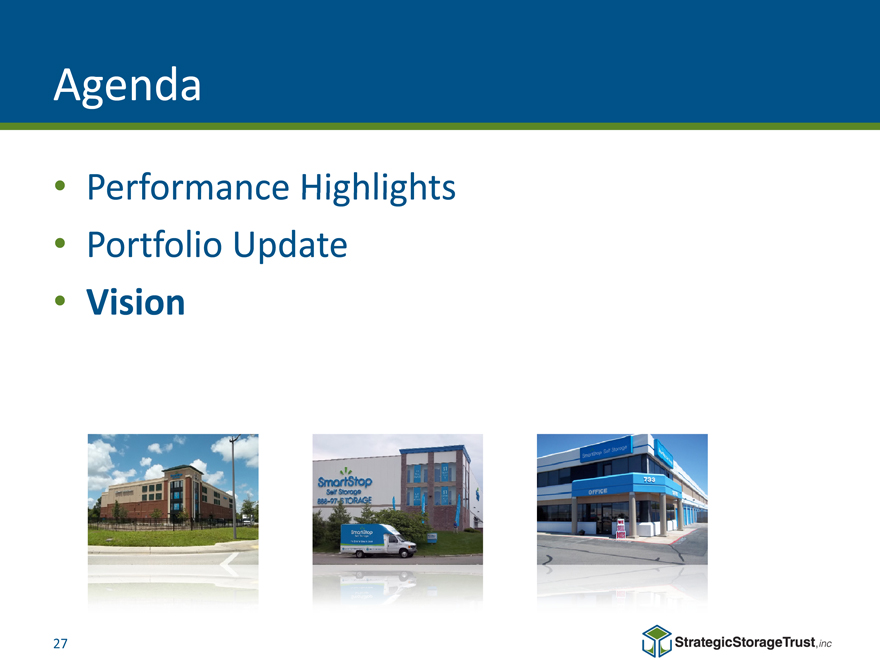
Agenda
Performance Highlights
Portfolio Update
Vision
27
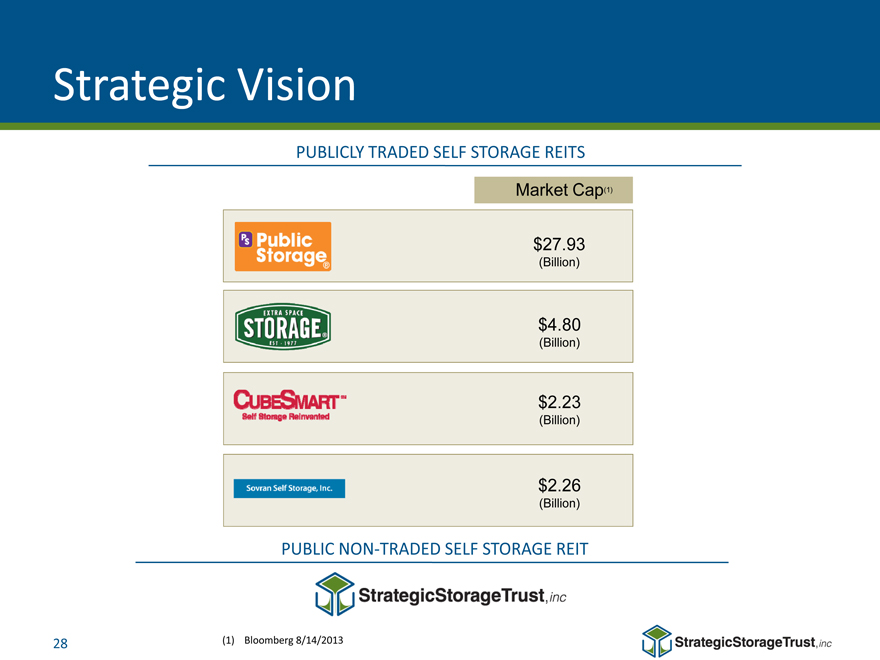
Strategic Vision
PUBLICLY TRADED SELF STORAGE REITS
Market Cap(1)
$27.93
(Billion)
$4.80
(Billion)
$2.23
(Billion)
$2.26
(Billion)
PUBLIC NON-TRADED SELF STORAGE REIT
28 (1) Bloomberg 8/14/2013

Questions?
29
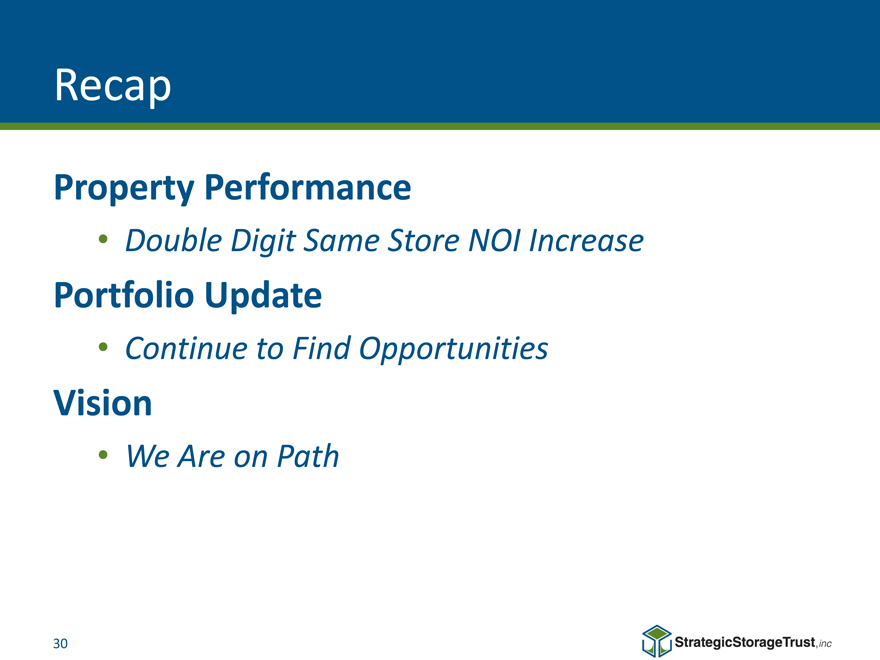
Recap
Property Performance
Double Digit Same Store NOI Increase
Portfolio Update
Continue to Find Opportunities
Vision
We Are on Path
30
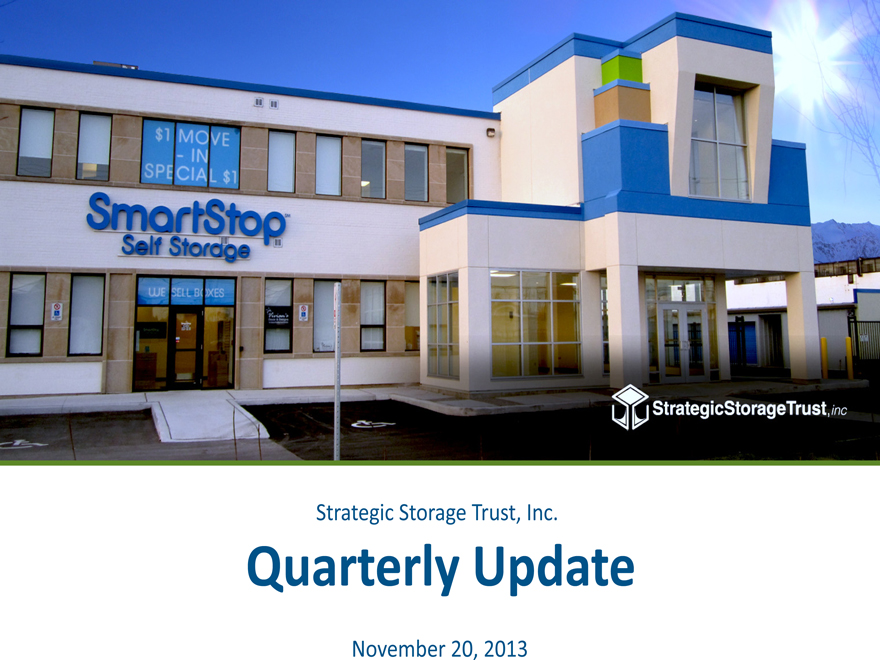
Strategic Storage Trust, Inc.
Quarterly Update
November 20, 2013






























